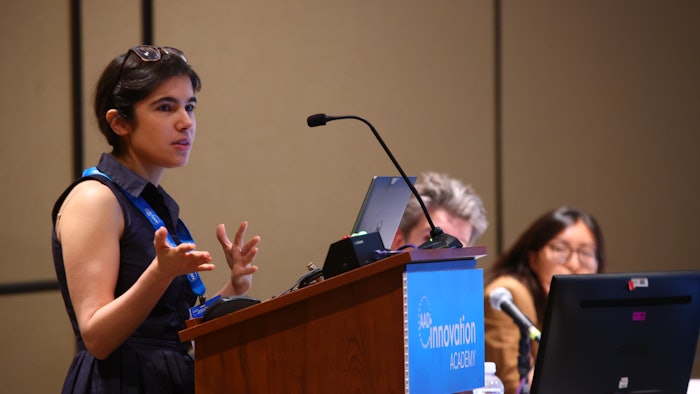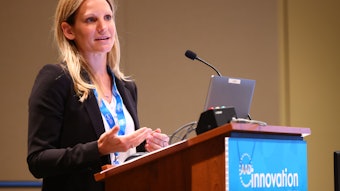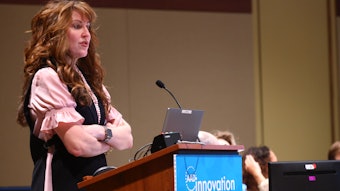Emerging oncodermatology
Dermatologists expand their knowledge of a rising subspecialty.

P004 – Updates in Oncodermatology
The National Cancer Institute predicts that more than two million people in the United States will be diagnosed with cancer in 2024. As cancer screenings, diagnoses, and treatments continue to advance, so too has the need for a new subspecialty. Friday’s session, P004 – Updates in Oncodermatology, delivered an enlightening overview of the emerging practice, led by session director Fiorinda F. Muhaj, MD, FAAD, associate professor of dermatology at MD Anderson Cancer Center in Houston.
In the last 20 years, oncodermatologists have begun filling an important new role on patients’ cancer teams, working alongside oncologists and other clinicians to treat and prevent cutaneous adverse effects of cancer therapy, which can greatly impact a patient’s quality of life. Toxic reactions to cancer treatments may include skin, nail, hair, and mucosal side effects. The goal for dermatologists, said Dr. Muhaj, is to provide supportive care in compliance with cancer therapy.
“As oncodermatologists, our focus is to administer treatments that are not only effective and safe, but most importantly would not interfere with the wanted anti-tumor effects of immunotherapy or targeted therapy,” she said.
Teaming up for healthy immunity
In the setting of immunotherapy, it is common for patients to experience immune-related cutaneous adverse events (irCAEs), said Dr. Muhaj and fellow speaker Noah Io Hornick, MD, PhD, FAAD, assistant professor of dermatology at Oregon Health & Science University in Portland. In fact, irCAEs can affect 70-90% of cancer patients, typically early in their treatment course. These skin toxicities can be life-altering, especially when other types of adverse events are occurring throughout the body during an already vulnerable time of life. Examples range from remediable conditions, such as morbilliform rash, psoriasis, eczema, pruritus, vitiligo, or lichenoid dermatitis, to more rare, severe conditions, such as autoimmune blistering diseases, autoimmune connective tissue diseases, toxic epidermal necrolysis (TEN), Stevens-Johnson syndrome (SJS), or drug reaction with eosinophilia and systemic symptoms (DRESS).
Collaborating with oncologists and other specialists to promptly diagnose, grade, and treat irCAE symptoms is critical and transformational for the patient, said Dr. Muhaj. Without the involvement of dermatology and proper treatment, the morbidity associated with irCAEs may cause clinicians to lower treatment dose or suspend immunotherapy.
On target treatments
For some malignancies, targeted therapies have replaced traditional chemotherapy as initial forms of treatment because they are more precise and effective. However, adverse events like skin toxicities are still to be expected. Dr. Muhaj spoke about epidermal growth factor receptor (EGFR) inhibitors as one type of targeted therapy that can cause a range of cutaneous reactions, including acneiform (or papulopustular) eruption, paronychia, mucositis, xerosis, hair changes, and photosensitivity. Often, a patient will experience significant morbidity as multiple toxicities present at the same time.
Multikinase inhibitors, another targeted therapy, can provoke hand-foot skin reactions, an effect that can be exceptionally painful and interfere with daily functions.
“Considering the life-saving nature of cancer therapeutics, it is critical for dermatologists to be able to offer effective management, thereby improving patient outcomes and influencing decisions for dose-reduction or drug discontinuation,” said Dr. Muhaj.
Reaction ready
Speaker Connie Shi, MD, FAAD, a dermatologist at Brigham and Women’s Hospital in Boston, addressed cutaneous considerations in patients with hematologic malignancies who are often predisposed to skin cancer or infection due to their immunosuppression. Hematologic transplant patients are also susceptible to graft versus host disease, which frequently targets skin as the primary organ.
It is essential to include a dermatologist in the care team to monitor the patient’s skin for any changes or adverse reactions, like eruptions, itching, ulcerations, or superinfections. There are numerous oncotherapeutics and combination treatments for hematologic and solid malignancies that are in the development and approval process.
“Some of the related cutaneous toxicities may be more intense than previously seen with respective monotherapies or altogether different toxicities related to a new drug’s mechanism of action,” said Dr. Muhaj.
As new therapies in dermatology emerge, the available treatment options for skin toxicities continue to improve. The speakers agreed that oncodermatology is a very exciting and fulfilling practice to be in — and an important subspecialty to be aware of and follow. For them, being able to improve the lives of cancer patients who ultimately are trying to survive is a meaningful achievement.
“It is important for us as oncodermatologists to share our experiences in order to provide the best care for our patients,” Dr. Muhaj said.
 Top row: Patient with acneiform eruption due to EGFR inhibitor therapy. This before and after image demonstrates the results of three weeks of systemic therapy with isotretinoin and topical corticosteroids. Bottom row: An oncodermatology patient with plantar psoriasis due to immunotherapy. This before and after image demonstrates the results after topical therapy with tapinarof 1% cream.
Top row: Patient with acneiform eruption due to EGFR inhibitor therapy. This before and after image demonstrates the results of three weeks of systemic therapy with isotretinoin and topical corticosteroids. Bottom row: An oncodermatology patient with plantar psoriasis due to immunotherapy. This before and after image demonstrates the results after topical therapy with tapinarof 1% cream.











